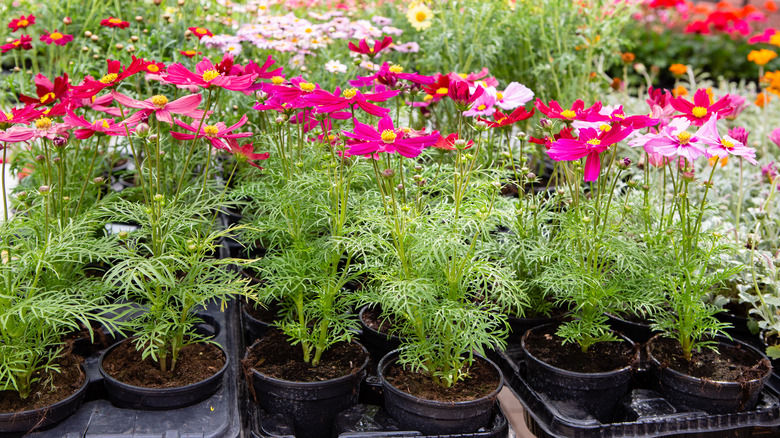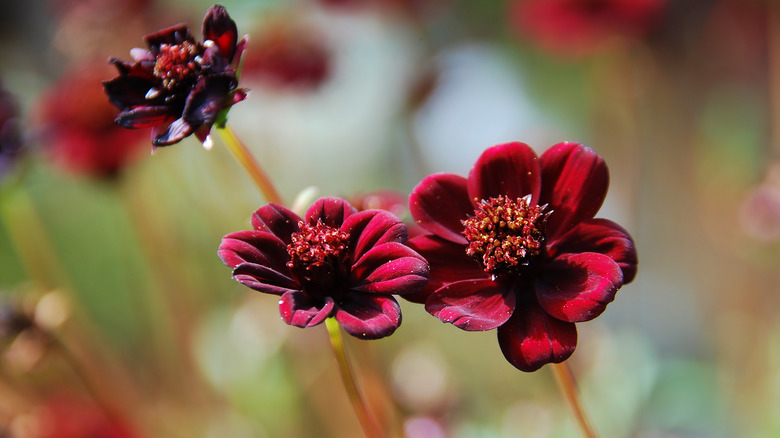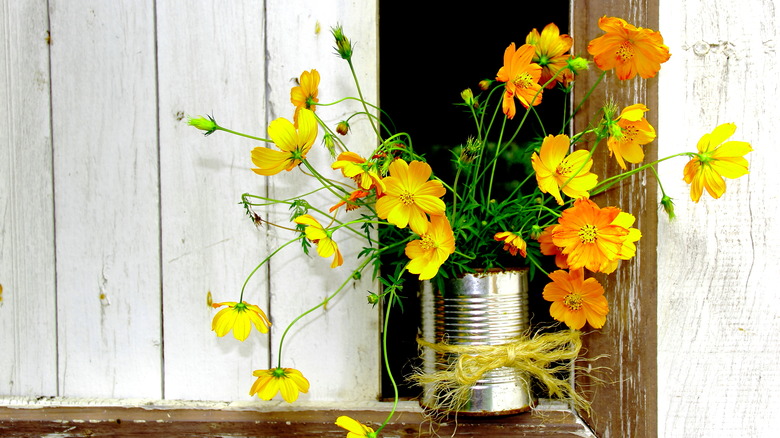How To Grow And Take Care Of Cosmos Plants
If you are looking for a plant for your garden that has colorful flowers and is easy to take care of, look no further than cosmos plants. These whimsical flowering plants come in a wide range of colors and have symmetrical petals surrounding their yellow center. These 2- to 3-inch flowers in colors such as pink, white, purple, red, orange, and chocolate, bloom during summer and autumn months, and grow on plants over a foot tall. Gardener's Path explains that there are over 20 varieties of cosmos, including cosmos sulphureus and cosmos bipinnatus, which are the most popular varieties.
Naturally found in South America, Central America, and southern North America, Spanish priests named these colorful flowers "cosmos" (meaning "harmony" in Greek) because of their symmetrical petals. Because cosmos are native to southern regions, they do incredibly well in hot, dry climates with poor soil. They are effortless to take care of, and some may even think of them as weeds because of how easily they grow, but have no doubts — cosmos are sure to give your garden a colorful pop.
How to use cosmos plants in garden
The colorful blooms of cosmos plants make them perfect for any garden, and they do especially well in cottage gardens which are more informal and random. The taller varieties of this plant work well in the middle or back of your ornamental garden, while the shorter varieties are suitable for along the edges of your garden. They work well with other annual plants like poppies, marigolds, and dianthus because of their bright colors.
Gardening Know How discusses some practical uses for cosmos as companion plants, which help neighboring plants by sharing nutrients or protecting from the elements. Specifically, it is beneficial to plant your cosmos near your tomato plants. Pollinators, such as bees, are attracted to cosmos, so planting your cosmos near your tomatoes will help increase how many tomatoes your plants produce. Cosmos also work well with beets and stand out amongst the dark red leaves of beet plants.
How to grow cosmos plants
It is almost impossible to mess up growing these colorful and low-maintenance flowers. Cosmos are planted directly from seeds, so you have two options when it comes to planting them, per Almanac. With either option, cosmos don't need a particular soil, and if your soil is too rich, the plant will grow more foliage than flowers. Cosmos should be planted in well-draining soil so they don't get too much water. Seeds can be planted directly outside during the spring when you are sure there will be no more frost. The seeds should be planted approximately a 1/4 inch deep in the soil, and you can either plant them a set distance apart, like 12 to 18 inches, or just scatter them throughout your garden.
The other way to grow cosmos is by planting the seeds inside your home using a seed starting mixture. Plant the cosmos seeds in the mix about four to six weeks before you want to plant them outside, keeping in mind that cosmos will not survive a frost. Once the seedlings are 3 to 4 inches tall, they can be transferred to 5-inch pots and then planted outdoors after the last frost. It should take around seven weeks for the cosmos to start blooming. Later in the season, when the flowers begin to fade, the seed heads will blow away and spread seeds throughout your garden so that you will get more cosmos flowers the following year.
How to care for cosmos plants
Caring for cosmos is easy considering they are very low maintenance. According to The Spruce, you don't even have to water these plants because they prefer to be dry. These flowering plants thrive in hot weather and can survive droughts. They don't need to be fertilized because it won't help them bloom. The most important aspect of caring for cosmos is sunlight because they need full direct sunlight throughout the day to bloom. They can survive with partial sunlight, but they will bloom less if they aren't in full direct sunlight.
Another essential part of caring for cosmos is deadheading faded blooms from the plants. This will allow new flowers to come in and enable the plant to thrive for longer. When autumn arrives and the temperatures start to drop, you can pull out your cosmos plants from the roots or leave them in place. If you leave them, the seeds from the faded flowers may spread, and you will have more cosmos the following year.
Varieties of cosmos plants
Cosmos are often used to bring a lot of color and interest into a garden, and with over 20 varieties of this plant, you have tons of shades and shapes to choose from. From white to deep red and sizes ranging to over a foot tall and spreading over several feet long, cosmos are a diverse garden plant. Gardeners World describes a few varieties of cosmos plants:
-
Cosmos bipinnatus "Sonata White": These are your standard, white, saucer-shaped cosmos, perfect for containers.
-
Cosmos bipinnatus "Fizzy Pink": Coming in various shades of pink, these popular cosmos work well in pots.
-
Cosmos atrosanguineus "Chocolate Cosmos": Native to Mexico, this variety of cosmos is cocoa colored and smells faintly of chocolate.
-
Cosmos "Gazebo Red": With its large red blooms and early blooming flowers, this cosmos plant is sure to stand out in your spring garden.
-
Cosmos "Sea Shells": This variety of cosmos features seashell-shaped petals and will add some visual interest to your garden.
Are cosmos plants toxic?
Love Your Dog expresses good news for pet owners: Cosmos are not toxic to your dogs or cats, making them a great plant to have in your garden if you have pets. There is no toxicity associated with cosmos, but as with anything, you don't want your pets eating too much of these flowers. Although small amounts of cosmos won't hurt your pets, large amounts of any plants may cause harm to your dogs and cats. So if you notice that your furry friend is constantly trying to eat your cosmos, it may be best to plant them somewhere where your pets can't reach them.
Cosmos are also not toxic to people, meaning that if you have young children who often roam through your garden, you won't have to worry about them eating these flowers. For this reason, cosmos make a perfect flowering plant to have in your family garden because it isn't harmful or toxic.
How to repot cosmos plants
Cosmos can grow really well in pots, making them easy to move around in your garden. Gardening Know How describes that two varieties of cosmos that work well in containers are cosmos sulphureus and cosmos bipinnatus. If you are growing cosmos in containers, you may want to repot them if they grow too big or if you notice their roots start coming out of the container's drainage holes. It is best to repot them in a larger container when this occurs, ensuring that the new container has drainage holes and loose potting soil.
To repot your cosmos, pour some potting soil with a slow-release fertilizer in the bottom of your new container. Then gently pull your cosmos out of their original pot and move them into the new pot. Fill the rest of the pot with more soil and water the plant. Going forward, your cosmos won't need much watering as they do better in drought conditions. Continue to deadhead and maintain your cosmos for a colorful garden throughout the summer and autumn months.






